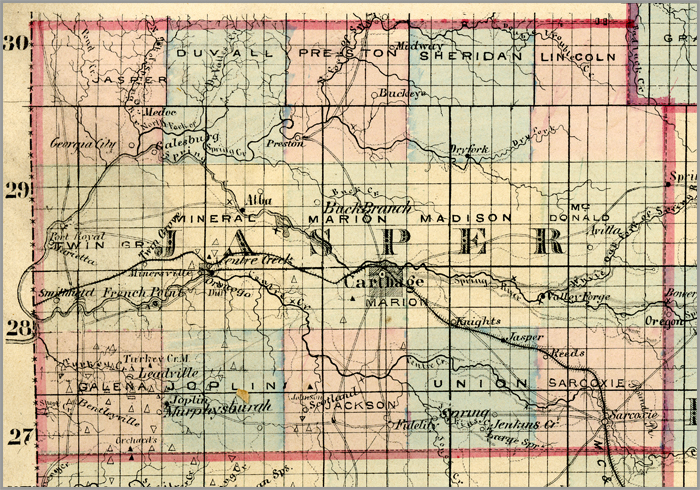Jasper County, Missouri

- Formed: 1838
- County Population 1860: 6,548
- Slave Population 1860: 334
- Civil War Engagements
-Battle of Carthage, July 5, 1861
-Engagement at Shirley’s Ford, September 1862
-Action at Rader Farm/Burning of Sherwood, May 18-19, 1863
-Shelby’s Raid, October 18, 1863
Image courtesy of Wilson’s Creek National Battlefield
The early pioneers that settled the area that encompasses present-day Jasper County knew the region as the “Country of the Six Bulls.” Spring River, the principal water source in Jasper County, was a major tributary to the Neosho River that flows in Northeast Oklahoma and Southeast Kansas. The Neosho, also known as Grand River, was called “Six Bulls River” in the early 1800’s.
Pioneer settlement in the area of present-day Jasper County followed the removal of Native American tribes from the Southwestern region of Missouri. The first to be removed from the region were the indigenous Osage. The Kickapoo, Delaware and Shawnee, Eastern tribes that had been moved to Missouri, relinquished their lands, and by the late 1830’s had all been moved to the Kansas Territory.
Jasper County was established as a political entity on Jan. 29, 1841. The name Jasper, popularly used for cities and counties of that era, refers to Sergeant William Jasper, a heroic figure of the Revolutionary War. Another popular name, Carthage, was chosen for the county seat with the new community being created in the spring of 1842.
The principal towns and villages of early Jasper County were: Sarcoxie, the oldest settlement, located in the Southeast part of the county; Carthage in the center of the county; and Sherwood in the west, located south of present-day Carl Junction. The first twenty years of settlement had established a rich farming tradition. The county was plentiful in corn, wild berries, deer, turkey and domesticated livestock. The profile of a hog would adorn the first Jasper County Government Seal. This prosperity and abundance would eventually lead to the destruction of the County, as Northern and Southern forces would strip the County of its valuable resources during the Civil War.
In July 1861, Jasper County would receive national attention for the Battle of Carthage. Upon learning that Union Col. Franz Sigel had encamped at Carthage, on the night of July 4, Gov. Claiborne F. Jackson took command of the 4,000 State Guardsmen with him and formulated a plan to attack the small Union force. The next morning, Jackson closed up to Sigel, established a battle line on a ridge ten miles north of Carthage, and induced Sigel to attack him. The Confederates pursued, but Sigel conducted a successful rearguard action. By evening, Sigel was inside Carthage and under the cover of darkness; he retreated to Sarcoxie. Missouri Governor Claiborne F. Jackson and his pro-southern Missouri State Guard would receive praise from the newly formed Confederate Government for their first victory for southern forces in Missouri.
However, following the Confederate defeat at Pea Ridge Arkansas in March of 1862, Jasper County and the rest of Southwest Missouri would be embittered by devastating guerrilla warfare. On May 18 and 19, 1863 there was a small skirmish at Rader’s Farm and the town of Sherwood was burned. The foremost Southern Partisan in Jasper County and along the border region of Southwest Missouri was Thomas R. Livingston. From his base of operations at French Point on Center Creek north of present-day Joplin, Livingston’s Southern Sympathizers would threaten Union Militia and supply trains providing material for Union troops along the Military Road from Ft. Scott to Baxter Springs in Kansas, to Ft. Gibson in the Indian Territory. Confederates, like Joseph Shelby, conducted several raids in an attempt to regain land, but proved unsuccessful. Bushwhackers or those who were not officially aligned with either side took advantage of the chaos for their benefit. These bands of men were responsible for huge amounts of violence and destruction in the county. By the end of the war much of the county had been burned and depopulated.
The discovery of rich lead deposits along Joplin Creek in the southwest part of the county in 1871 would hasten the recovery from the devastation caused by the war. New mining towns of Joplin, Webb City and Carterville, along with the pre-war town of Minersville (now Oronogo) would fill a national need as thousands of families came to the region looking for work and hoping for prosperity in the 1870’s depression-era America. By the 1890’s, Jasper County, as well as portions of Southeast Kansas and Northeast Oklahoma, would become one of the largest lead and zinc mining districts in the nation.
 Browse all collections in Jasper County
Browse all collections in Jasper County
- Consulted:
- Jasper County, MO, 1860 U.S. Federal Census – Slave Schedules [database on-line]. Provo, UT, USA: Ancestry.com Operations Inc., 2004. Original data: United States of America, Bureau of the Census. Eighth Census of the United States, 1860. Washington, D.C.: National Archives and Records Administration, 1860. M653, 1,438 rolls.












